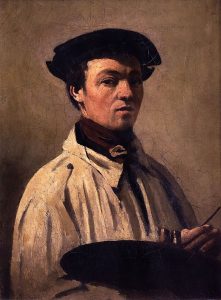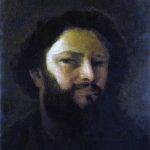
Movement(s): Realism
Jean-Baptiste Camille Corot (1796 – 1875) was a French landscape and portrait painter as well as a printmaker in etching. He is a pivotal figure in landscape painting and his vast output simultaneously references the Neo-Classical tradition and anticipates the plein-air innovations of Impressionism.
His family were bourgeois people—his father was a wigmaker and his mother a milliner—and unlike the experience of some of his artistic colleagues, throughout his life he never felt the want of money, as his parents made good investments and ran their businesses well. After his parents married, they bought the millinery shop where his mother had worked and his father gave up his career as a wigmaker to run the business side of the shop. The store was a famous destination for fashionable Parisians and earned the family an excellent income. Corot was the second of three children born to the family, who lived above their shop during those years.
Corot received a scholarship to study at the Lycee Pierre-Corneille in Rouen, but left after having scholastic difficulties and entered a boarding school. He “was not a brilliant student, and throughout his entire school career he did not get a single nomination for a prize, not even for the drawing classes.” Unlike many masters who demonstrated early talent and inclinations toward art, before 1815 Corot showed no such interest. During those years he lived with the Sennegon family, whose patriarch was a friend of Corot’s father and who spent much time with young Corot on nature walks. It was in this region that Corot made his first paintings after nature.
With his parents’ support, Corot followed the well-established pattern of French painters who went to Italy to study the masters of the Italian Renaissance and to draw the crumbling monuments of Roman antiquity.
When out of his studio, Corot traveled throughout France, mirroring his Italian methods, and concentrated on rustic landscapes. He returned to the Normandy coast and to Rouen, the city he lived in as a youth. Corot also did some portraits of friends and relatives, and received his first commissions. His sensitive portrait of his niece, Laure Sennegon, dressed in powder blue, was one of his most successful and was later donated to the Louvre. He typically painted two copies of each family portrait, one for the subject and one for the family, and often made copies of his landscapes as well.
Despite great success and appreciation among artists, collectors, and the more generous critics, his many friends considered, nevertheless, that he was officially neglected, and in 1874, a short time before his death, they presented him with a gold medal. He died in Paris of a stomach disorder aged 78 and was buried at Père Lachaise Cemetery.
A number of followers called themselves Corot’s pupils. The best known are Camille Pissarro, Eugene Boudin, Berthe Morisot, Stanislas Lepine, Antoine Chintreuil, Francois-Louis Francais, Charles Le Roux, and Alexandre Defaux.
Click here to read Corot’s full bio on Wikipedia.
Corot painted in many places in France, here they are (a link “⇠” will appear to his works below when published):
- Auvergne-Rhone-Alpes
- Monnetier-Mornex
- Bourgogne-Franche-Comte (Burgundy)
- Lormes
- Macon
- Sens
- Brittany
- Dinan
- Centre-Val de Loire
- Beaune-la-Rolande
- Chartres
- Epernon
- Orleans
- Hauts-de-France
- Arras
- Beauvais
- Boulogne-sur-Mer
- Douai
- Dunkirk
- Essomes-sur-Marne
- Marissel
- Pas-de-Calais
- Pierrefonds
- Saint Quentin Des Pres
- Soissons
- Normandy
- Caudebec-en-Caux (surrounding only) ⇠
- Jumieges ⇠
- Dieppe ⇠
- Etretat ⇠
- Le Havre ⇠
- Le Treport
- Rouen
- Saint Lo
- Trouville-sur-Mer
- Caudebec-en-Caux (surrounding only) ⇠
- Nouvelle-Aquitaine
- La Rochelle
- Mont-de-Marsan
- Occitanie
- Villeneuve-les-Avignon
- Provence-Alpes-Côte d’Azur
- Antibes
- Avignon
- Toulon
Related Posts
- 10000
 Jean-Baptiste Camille Corot was a French painter of the Realism movement. He travelled extensively between France and Italy. Although he did paint in a few cities in Normandy, one only in Le Havre (and one on next door city of Sainte-Addresse), most of his works centers around Italy.
Jean-Baptiste Camille Corot was a French painter of the Realism movement. He travelled extensively between France and Italy. Although he did paint in a few cities in Normandy, one only in Le Havre (and one on next door city of Sainte-Addresse), most of his works centers around Italy. - 95
 Jean Desire Gustave Courbet (1819 – 1877) was a French painter who led the Realism movement in 19th-century French painting. Committed to painting only what he could see, he rejected academic convention and the Romanticism of the previous generation of visual artists. Courbet, a socialist, was active in the political…
Jean Desire Gustave Courbet (1819 – 1877) was a French painter who led the Realism movement in 19th-century French painting. Committed to painting only what he could see, he rejected academic convention and the Romanticism of the previous generation of visual artists. Courbet, a socialist, was active in the political… - 86
 Jules Coignet, was a French painter who specialized in Idealists and Realists Landscape paintings. He travelled extensively in France and even in Europe, painting many of the landmarks in cities. Unfortunately, there are not many of his painting left.
Jules Coignet, was a French painter who specialized in Idealists and Realists Landscape paintings. He travelled extensively in France and even in Europe, painting many of the landmarks in cities. Unfortunately, there are not many of his painting left. - 86
 Alfred Emile Leopold Stevens was a Belgian painter, known for his paintings of elegant modern women.
Alfred Emile Leopold Stevens was a Belgian painter, known for his paintings of elegant modern women. - 84

